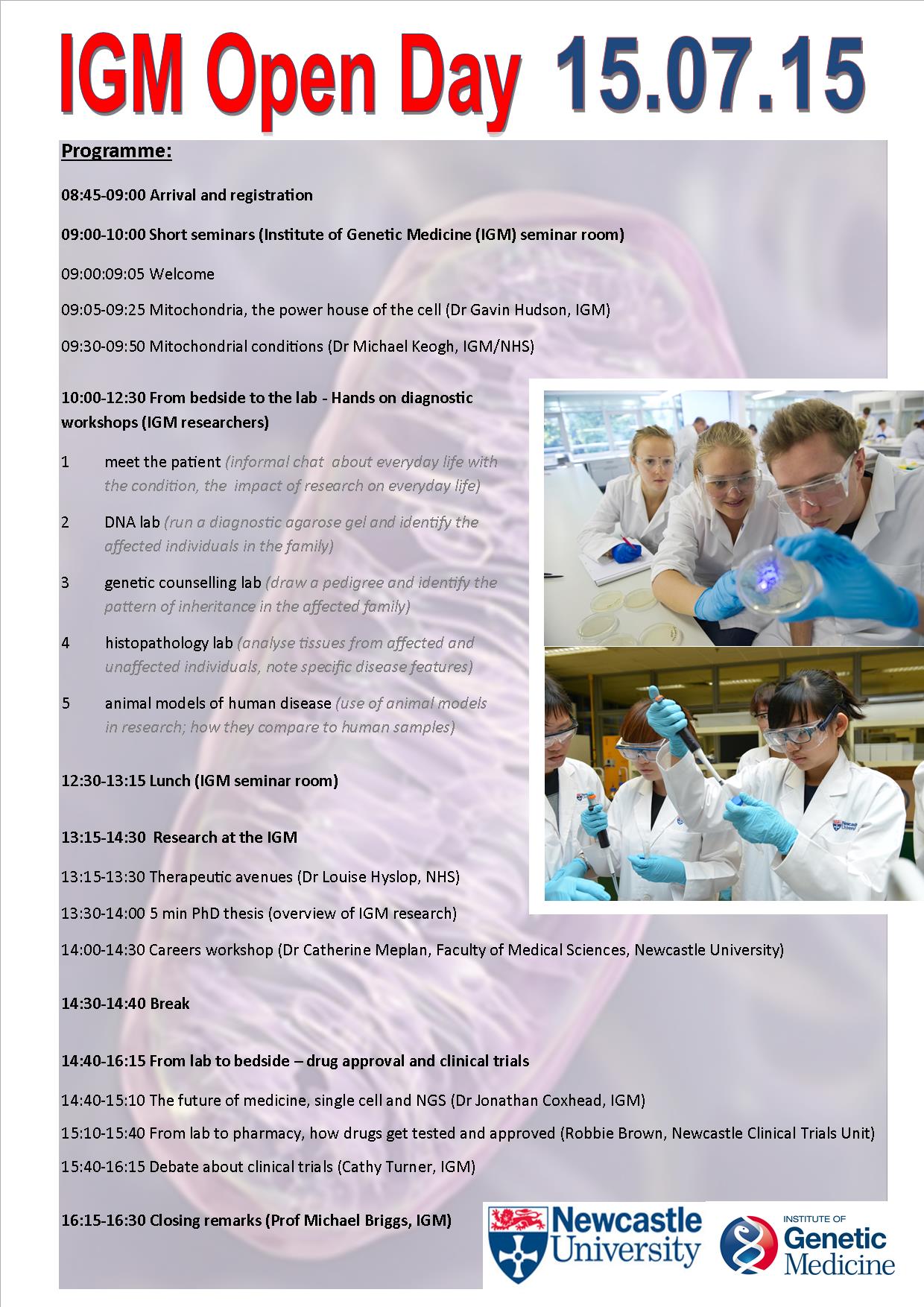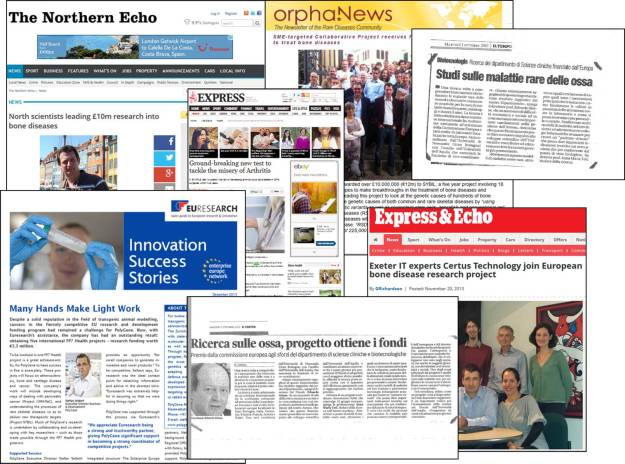Our “Genetics Matters” event has been recognised by the University and we have been invited by the Vice-Chancellor to attend the “Celebrating Success Event”!
All posts by Katarzyna
Trouble with Tribbles..
TRIB1 (Tribbles Pseudokinase 1) is a protein containing a serine/threonine kinase-like domain which is expressed in skeletal muscle, thyroid, pancreas, peripheral blood leukocytes, and bone marrow. Trib1 is critical for the differentiation of tissue-resident macrophages and in musculoskeletal tissues it is highly expressed in the bone marrow of adult humans. However, its role in skeletal tissues is currently unknown.
In collaboration with Prof Drew Rowan at Newcastle University, we have been analysing a mouse model which overexpresses Trib1 in cartilage (under col2 promoter).
We have found that mice overexpressing Trib1 in cartilage (right) are much smaller than the wild type litter mates (left) and present with a pronounced hip dysplasia. The bones appear dense, shorter and broader and are very reminiscent of osteopetrosis (“the stone bone” disease).
 Jennifer Gerbracht, an Erasmus student in the lab, generated this bone density image (above) using bone mineral content quantification by Faxitron X-ray microradiography. The image was pseudocoloured, showing the densest material in red. The knee joint of a wild type mouse (left) is shown compared to a mutant mouse (right) with much higher bone density.
Jennifer Gerbracht, an Erasmus student in the lab, generated this bone density image (above) using bone mineral content quantification by Faxitron X-ray microradiography. The image was pseudocoloured, showing the densest material in red. The knee joint of a wild type mouse (left) is shown compared to a mutant mouse (right) with much higher bone density.
15th July 2015 A-level Open Day
On the 15th of July the IGM are hosting our regular IGM Open Day for the lower 6th form students from local schools.
Final programme for the day:
The event will include hands on experiments and a “bench to bedside” journey in mitochondrial genetics as well as a short presentation about studying at the University. Thank you very much to all participants and a big thank you to all the staff and students from IGM for taking time off to present their research and to the staff at the Centre for Life for their help with the practical sessions.
If you would like to participate in a similar event next year, please email IGMengagement@ncl.ac.uk
Mouse models in investigation of human genetic skeletal diseases – a review

The utility of mouse models to provide information regarding the pathomolecular mechanisms in human genetic skeletal diseases: The emerging role of endoplasmic reticulum stress.
Available as open access here
Or download a .pdf file here: ER stress review
A little “thank you” from project students..
PhD studentship available
The Peter May Arthritis MRes/PhD studentship – Biomechanical sensing in cartilage ageing and disease
Value of award: The funding covers one year MRes followed by a three year PhD. The full award covers tuition fees at the UK/EU rate and an annual stipend of £13,986 (2015-2016). Funding is restricted to Home/EU fees only.
Start date: September 2015 – the funding covers a 4 year PhD
Application closing date: 31/05/15
Supervisor(s): Dr Katarzyna Piróg, Prof David Young
Overview
Osteoarthritis (OA) results from a micro-damage to cartilage and propagates via the subsequent repair/damage events. The remodelling capabilities of tissue decrease with age, leading to increased OA susceptibility following injury related trauma. Interestingly, investigation of biomechanical responsiveness of chondrocytes themselves is a relatively recent topic and the reaction of cells to the abnormal extracellular matrices remains largely unknown. This PhD project will aim to establish a biomechanically relevant 3D in vitro model of young and aged cartilage and test the reaction of cells to different extracellular environments. The resulting in vitro system will generate new knowledge about the mechanosensitivity of the chondrocyte and provide a platform for further studies of potential therapeutic interventions for cartilage disorders in a relevant in vitro setting.
The successful applicant will benefit from a supervisory team that brings together expertise in cartilage biology, functional genetics and applied bioinformatics. Both supervisors are PIs in the pan-European EU-FP7 SYBIL research consortium bringing together the expertise of 18 cartilage and bone biology research centres. The group also enjoys a collaborative link with the CIMA (Centre for Integrated research into Musculoskeletal Ageing) project and the Musculoskeletal Research Group (MRG) at Newcastle University. The PhD student will receive extensive training in histology, cell culture, “omics” technologies, biomechanics, biochemical assays, statistical analysis and project management, thus obtaining a desirable and transferable skillset.
One PhD studentship is available in the Newcastle group of Dr Katarzyna Pirog, with Prof David Young as co-supervisor. Students with an interest in ageing, cartilage biology, animal models of disease, biochemistry, and transcriptomics are encouraged to apply.
Eligibility Criteria: You must have, or expect to achieve, at least a 2:1 Honours degree in genetics, biochemistry, biosciences or a related area. The award is available to UK/EU applicants only. If English is not your first language, you must have IELTS 7, or equivalent.
How to apply: You must apply through the University’s online postgraduate application system by creating an account. To do this please select ‘How to Apply’ and choose the ‘Apply now’ button.
You should also send your covering letter and CV to Dr Katarzyna Pirog by email to katarzyna.pirog@ncl.ac.uk
Contact: Dr Katarzyna (Kasia) Piróg, Institute of Genetic Medicine, Newcastle University.
Email: katarzyna.pirog@ncl.ac.uk
Genetics Matters! 27th February 2015
This year for Rare Disease Day 2015 we helped organise and will be participating in the Genetics Matters event at the Great North Museum in Newcastle:
 We will be presenting our best research in genetics and rare diseases, answering questions, engaging in debates and presenting hands on research tables. There are over 7,000 known rare diseases, most of which are genetic.
We will be presenting our best research in genetics and rare diseases, answering questions, engaging in debates and presenting hands on research tables. There are over 7,000 known rare diseases, most of which are genetic.
1 in 17 people will be affected by a rare disease at some point in their lives. This amounts to a staggering 3.5 million people in the UK alone! Genetic research and research into Rare Diseases may not attract much media attention but it is of high importance for the modern developed societies.
Come see us at the Great North Museum on the 27th February 2015 (Rare Disease Day) to learn more
The full programme can be viewed here Genetics Matters 2015 final programme
Cartilage-Specific Ablation of XBP1 Signaling – research paper
 Cartilage-Specific Ablation of XBP1 Signaling in Mouse Results in a Chondrodysplasia Characterised by Reduced Chondrocyte Proliferation and Delayed Cartilage Maturation and Mineralization
Cartilage-Specific Ablation of XBP1 Signaling in Mouse Results in a Chondrodysplasia Characterised by Reduced Chondrocyte Proliferation and Delayed Cartilage Maturation and MineralizationNewcastle-Manchester skeletal genetics meeting
On 10th December 2014 we hosted a collaborative meeting with a skeletal genetics group from the Wellcome Trust Centre for Cell Matrix Research in Manchester.
The meeting was very well attended and much fun was had too!
SYBIL in the news so far
The members of SYBIL (Systems biology for the functional validation of genetic determinants of skeletal diseases), the EU-FP7 collaborative project which we’re participating in, were certainly busy in 2014. Here’s a compliation of recent press releases:









